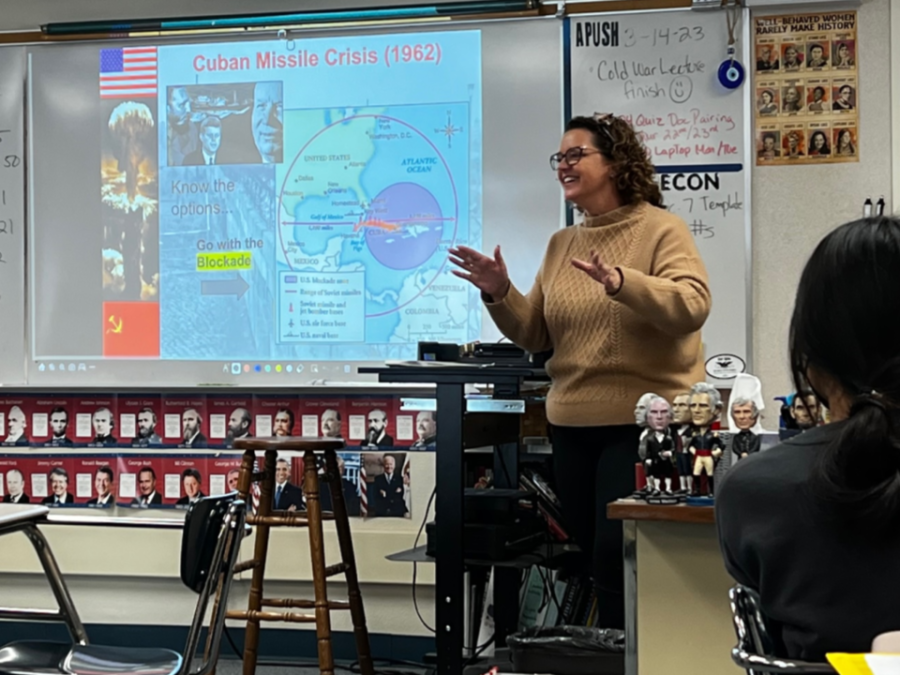Teacher Profile: Mairi Wolgemuth’s journey as the only APUSH teacher at Amador
Ms. Wohlgemuth has had much fun teaching history at Amador for 29 years.
Mairi Wohlgemuth, or as her students call her, Ms. Woogie, began teaching at Amador in the fall of 1994. She started her career teaching Freshmen Global Studies and regular US History. After six years, when the position of AP US History teacher became available, she decided to give it a try.
“I really enjoyed covering so much ground in a single year and learning how best to prepare students for the test,” said Wohlgemuth. “I remember reading the book along with the students that first year. I was only maybe a chapter ahead of them the whole time, but I learned a lot!”
Wohlgemuth has always had an affinity for history. She earned her college degree in anthropology and archaeology, which piqued her interest because of the story that the unearthed artifacts told.
“I love that [history] is a story,” said Wohlgemuth. “I enjoy telling stories, jokes, puns, and laughing while learning at the same time! History is about people, their choices, discoveries, and interactions.”
Teaching was part of Wohlgemuth’s life for nearly all of it. Her mother was a teacher, and she herself began teaching at a young age.
“When I was in 6th grade myself, I taught my best friend all the steps to a Scottish sword dance so we could perform it together at the end-of-the-year assembly,” said Wohlgemuth. “I then began teaching summer camps after high school in color guard and knew I had a knack for breaking down complicated tasks into easy-to-digest parts.”
Wohlgemuth is highly aware that APUSH is a very difficult course. That’s why she obliges herself to engage her students in different ways.
“Because APUSH covers so much content the main strategy I use is the lecture,” said Wohlgemuth. “I have become an entertaining lecturer over the years to try to keep my class from becoming bored. To make history come alive, I also interject plenty of video clips. I try to implement an activity for each unit for students to dive deeper into topics, like the Progressive Era Speed Dating.”
Wohlgemuth’s strategies to keep students engaged work quite well. Many of her students greatly enjoy the atmosphere of the class.
“The environment in Woogie’s classroom is really cool,” said APUSH student Ajay Reyes (‘24). “Everybody just jokes with each other, including Ms. Woogie. It’s very comfortable, and it’s not super serious or stressful.”
Being the only APUSH teacher at Amador, there are pros and cons for Wohlgemuth. While it gives her freedom to customize her lessons to her preference, it also takes away the collaboration aspect, since there are no other teachers in the course.
“There are positives and negatives to being the only APUSH teacher,” said Wohlgemuth. “One positive is having autonomy in pacing and lesson planning. On the other hand, I miss out on collaborating with colleagues on campus. I do have an online community of APUSH teachers around the country I collaborate with for ideas and updates on the exam.”
In Wohlgemuth’s 29 years of teaching, she has had lots of fun teaching, talking, and laughing with students. She believes that one of the most important aspects of teaching is forming relationships with her students.
“I enjoy keeping in touch with many past students‒ some are even fellow colleagues here at Amador,” said Wohlgemuth. “The highlights of teaching are seeing a student fill with confidence by earning a 5 on the national exam after a year of self-doubt. I love seeing potential in students and nurturing that success. The greatest thing about teaching high schoolers is the point in their life that you intersect: they are on the precipice of adulthood and going on to college and careers. I have one of the last chances to set them up for success and see them take off on their own after graduation. Plus, teenagers crack me up, I laugh every day at work! Everybody should find a career that makes them do that!”
Your donation will support the student journalists in the AVJournalism program. Your contribution will allow us to purchase equipment and cover our annual website hosting costs.

